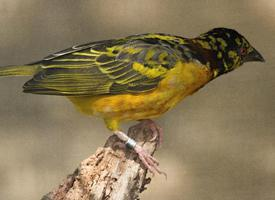
Poids et mesures
| Longueur | de 11 à 14,5 cm |
|---|
Description de l'animal
The Southern Masked Weaver (Ploceus velatus) is a fascinating and vibrant bird species, belonging to the Ploceidae family, which is known for its remarkable nest-weaving abilities. This small yet striking bird is predominantly found across the southern regions of Africa, thriving in a variety of habitats including savannahs, grasslands, and even human-altered landscapes such as gardens and parks. The species exhibits a notable sexual dimorphism, particularly in its plumage, making the males and females easily distinguishable during the breeding season.Males are renowned for their vivid yellow bodies contrasted with a dark, black facial mask that extends from the forehead, through the eyes, to the throat, giving the species its name. The intensity of the yellow plumage can vary among individuals, with some displaying a rich, golden hue. The wings and back are a lighter, greenish-yellow, providing a subtle camouflage among the green foliage. In contrast, the females and non-breeding males have a more subdued coloration, primarily olive or brown, which offers them better protection against predators.
One of the most remarkable behaviors of the Southern Masked Weaver is its intricate and elaborate nest-building process, predominantly undertaken by the males in an attempt to attract a mate. These nests are woven with remarkable precision and skill, using strips of reeds, grasses, and other available vegetation. The construction of these spherical nests, often suspended from the tips of tree branches over water or in dense vegetation, is an incredible feat, taking several days to complete. The entrance, facing downwards, provides additional protection against predators and elements.
The male's ability to construct a sturdy and aesthetically pleasing nest is crucial, as it forms the basis of the female's selection criteria. Females will meticulously inspect the nest's quality and, if satisfied, will choose to mate with the nest builder. Following a successful mating, the female lays between 2 to 4 eggs, which she incubates for about two weeks until they hatch. Both parents are involved in feeding the brood, showcasing a cooperative parenting style until the young are ready to fledge.
Southern Masked Weavers are social birds, often seen in flocks, especially outside the breeding season. They communicate through a series of chirps and songs, which play a vital role in social interactions and territorial defense. Their diet mainly consists of seeds, grains, and insects, making them both granivorous and insectivorous.
Conservation-wise, the Southern Masked Weaver is classified as Least Concern by the International Union for Conservation of Nature (IUCN), indicating a stable population across its range. This resilience is partly due to its adaptability to various environments, including those altered by human activity. However, like many species, it faces threats from habitat loss and degradation, necessitating ongoing monitoring and conservation efforts to ensure its continued survival.
In conclusion, the Southern Masked Weaver is a remarkable example of avian adaptation and skill, captivating birdwatchers and nature enthusiasts with its vibrant colors, intricate nests, and complex social behaviors. Its presence across the southern African landscape is a testament to the diversity and beauty of the region's avian fauna.
Animaux similaires
Nouvelles photos d'animaux
Top 10 des animaux
- Dolphin gull (Leucophaeus scoresbii)
- Japanese macaque (Macaca fuscata)
- Greek tortoise (Testudo graeca)
- Stone loach (Barbatula barbatula)
- Russian tortoise (Testudo horsfieldii)
- Galápagos tortoise (Geochelone nigra complex)
- Diana monkey (Cercopithecus diana)
- Moustached guenon (Cercopithecus cephus)
- Common flying dragon (Draco volans)
- Galápagos penguin (Spheniscus mendiculus)

